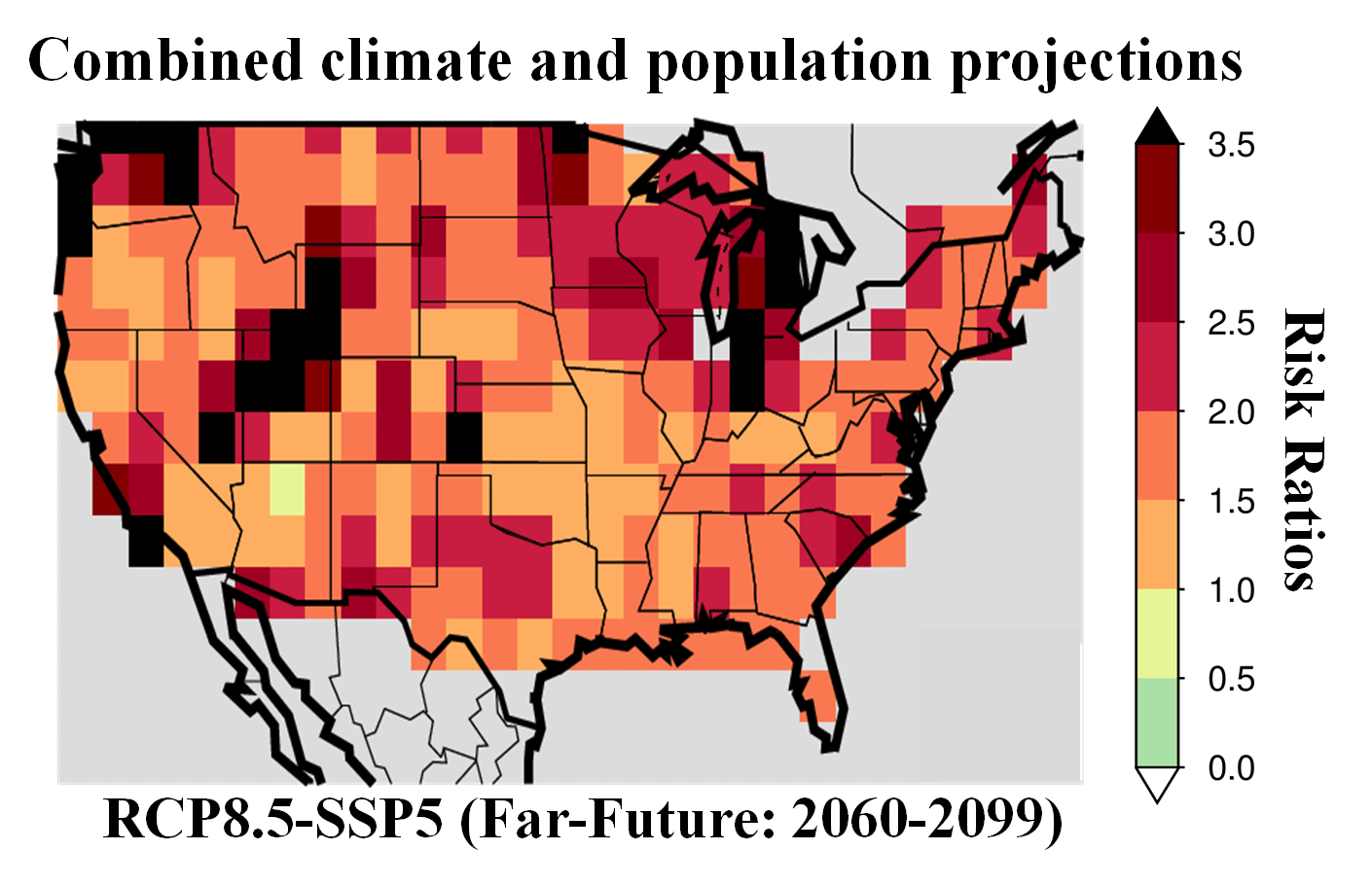
Potential heat stress risk due to climate, population growth, and combined climate and population projections, if greenhouse gas emissions remain high (the 'RCP8.5 senario) through the end of the century. Additional information in figure 3 of the new study.
Credit: Mukherjee et al. (2021) Earth's Future 10.1029/2020EF001886
Periods of extremely high heat are projected to double across the lower 48 states by 2100 if the world continues to emit high levels of greenhouse gases, according to a new study in Earth's Future, AGU's journal for interdisciplinary research on the past, present and future of our planet and its inhabitants.
This heat stress will be felt strongest in areas with growing populations. Regions like the Pacific Northwest, Central California and the Great Lakes region could experience as much as a threefold increase compared to the past 40 years. Heat stress occurs when both the temperature and relative humidity gets high enough that the human body can't get rid of the excess heat, leading to problems like strokes, heat cramps and other symptoms.
"Without doing any mitigation strategies, the impact of heat stress is likely to increase," said Ashok Mishra, an associate professor in civil engineering at Clemson University in South Carolina, and an author of the new study.
Human-driven climate change is leading to an average increase in temperature across the world. But people don't necessarily notice a slow, even warming so much as extreme events like heat stress, which is projected to increase in many areas.
Mishra and his co-authors wanted to see how heat stress would increase at the same time as a general increase in temperature and relative humidity.
They assumed that while humans may experience higher temperatures on average in many areas, people will acclimatize to the new normal.
"No one has ever recognized the importance of how a body can acclimatize to a certain temperature in humid conditions," said Sourav Mukherjee, a PhD student supervised by Mishra at Clemson University and lead author of the new study.
But extremely high heat index peaks, above even the yearly median values, will continue to have negative impacts on human health.
While previous research has typically examined how extreme heat events may increase in severity, frequency and duration, most studies have only examined one of these in isolation. But Mishra and his colleagues calculated how all of these might increase together in the future under a high emissions scenario.
"Our study provides a more comprehensive assessment of the impacts of climate change on heat stress in the U.S. by integrating multiple variables from state-of-the-art climate and population projections," said Michael Mann, another co-author of the study and a researcher at the Pennsylvania State University. "Climate change could lead to massive human mortality in the decades ahead. Tens of millions of lives, it is estimated, might be lost due to climate change impacts by later this century. One of the principal contributors is heat stress."
Growing populations, rising temperatures
The study's authors first examined the heat stress of the past 40 years, from 1980 to 2019. They calculated one-day, three-day, and seven-day averages of heat index of each summer then looked at specific severity levels and how much higher the top periods were in that year to determine the amount of heat stress experienced in different areas of the contiguous U.S. They finally integrated these numbers with population data in those areas to assess the potential impact of heat stress.
"It's not very often you get someone trying to connect who's being impacted and how long they're being impacted," said Jon Buzan, a post-doctoral research at the University of Berne who studies heat stress but was not involved in the new research. "It's really good to see this kind of work being done."
The authors then compared this data to projected climate change models for the same areas for two future 40-year periods: from 2020 to 2059 and from 2060 to 2099. They used population change projections to determine where populations were like to grow and where they weren't.
They found that on average, the potential risk of heat stress experienced in the lower 48 states would double by 2100. But urban areas in central California, the Pacific Northwest and the Great Lakes region will see a threefold increase by 2100 since they are projected to increase in population.
"This new work provides a comprehensive assessment for present and projected future US population exposure to heat stress considering the combined effect of heat and humidity," said Jiacan Yuan, an associate professor of atmospheric and oceanic sciences at Fudan University in China who was not involved in this research. "It quantitatively identifies regional changes in the risk of heat stress at multiple levels of severity and duration, as well as the relative importance of climate change and population change."
Mukherjee said, "this information will surely lead to a better understanding of the potential risk of heat stress and aid the policy-makers in the early planning of mitigation strategies."
Buzan said that this type of analysis should be done for other parts of the world, now that these researchers have conducted it for the U.S. "It's important to get into how heat stress affects different parts of the world," he said.






